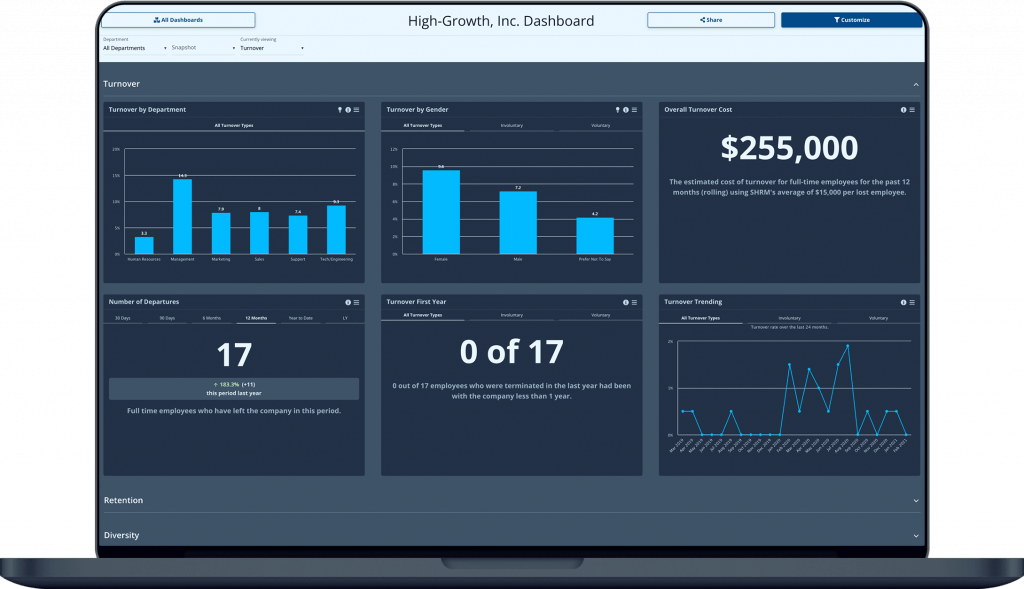Employee turnover is something that companies around the globe have been facing a lot of lately – especially with the Great Resignation at hand. So, how should companies try to fix their employee turnover? In this blog, we’ll explore exactly how to do so by taking a look at how companies evaluate their human resource (HR) data and what our suggestions are for leveraging it.
What is employee turnover and how do I measure it?
If you’re unaware, employee turnover is a metric that measures the number of employees who leave a company in a set period of time. There are multiple factors that can affect turnover rates, so making sure that you have actionable, concrete data helps you better understand how turnover became an issue, as well as potential ways to prevent its growth or decrease it.

To begin to better understand what matters with regards to employee turnover, ask yourself questions like, “Do we provide competitive benefits packages?” or, “Is our average salary comparable with our competitors?” Examine and try to better understand what your employees value most. Gathering this data can actually help you answer these questions – allowing you to examine if your turnover is “normal” (usually around 12-15%, according to the U.S. Bureau of Statistics), or if you need to find new ways to attract and retain quality employees.
If you’re like most companies, the data that you’re presently using is most likely manual, which takes enormous amounts of time to aggregate, before you can even evaluate it. Once you’ve done so, the next task that awaits you would be to take that data and turn each point into insights and action items. So, you’d be asking yourself at this point in the data game, “Now that I have it, what does it mean and how can I leverage it to create positive changes at my organization?” Next, we’ll explore how to take the data you’ve gathered to measure how to fix employee turnover.
Making your data actionable
Having actionable HR data helps you to better align your HR strategy with your organization’s overall goals. To start, take a moment and make a slight change to the way you see your role as an HR professional. Whatever you believe your role is at this point, we’d like to challenge you to see yourself as a product manager.
Your job is to sell your product to future employees and career pages. You’re also tasked with retaining your current customers – your employees. You may accomplish both of these tasks by making sure that your product is providing value – right? It’s a good idea to ask for feedback from those employees through surveys to check their satisfaction with your product (the company). Your job as a product manager (HR) is to analyze your data consistently to understand how to improve your product.
Taking action by creating transparency
Many HR managers feel left behind when they hear buzzwords like “AI,” “machine learning,” or “predictive analytics”, as most HR leaders are more comfortable sticking to spreadsheets to manage their HR data. But, when analyzing what businesses need to get out of their HR data and what will help HR managers in their roles, we’ve seen, after working with dozens of clients, that spreadsheets alone just don’t cut it. This is primarily because spreadsheets may indeed contain data, however, they typically lack easy-to-use analytics capabilities (without extensive data ranging and manipulation with vlookups). In addition to using a spreadsheet, an HR or business analyst must be leveraged to collate, read, calculate, and understand the data being aggregated.
Businesses need to get the value out of the data they have. But if it’s data that’s simply been compiled onto a spreadsheet, offering no way to understand it, then – is that data actually helpful? It’s extremely important for you to be able to take data and analyze how to take action from it. When data is provided to you in a way that’s transparent and easy for you to interpret (typically via a dynamic, unified data dashboard), you’ll then be able to demonstrate valuable points of action to executive leaders and team members to help solve real business problems – which is exactly what Employee Cycle’s HR dashboard can do.
Unify data with Employee Cycle’s HR dashboard
There are many reasons employees leave companies – and they say employees never leave companies where they are overpaid and overappreciated. So, it’s up to you and your department to figure out essential turnover metrics, as well as how to lower those rates – but, you don’t have to do that without help. Beginning to respond to employee data starts with having the right data points in the right place alongside the right tools that support your ability to easily analyze them. Employee Cycle delivers the proper technology and innovation for HR professionals to collect, organize, and analyze their HR data. Employee Cycle’s all-in-one People Dashboard integrates with your existing data systems to help you track metrics and master the art of HR reporting.

Schedule a demo with our data coaches today and see how you can transform your HR department and its ability to fix employee turnover by leveraging HR data with Employee Cycle.












